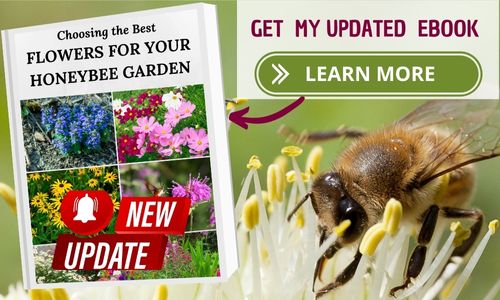Drought Tolerant Pollinator Plants
Planting to provide food for bees and other pollinators is a rewarding experience. However, this can be challenging in some regions. If you have an area that is especially dry or lacking in moisture -you need some drought tolerant pollinator plants that bees like. We must always match our plants to our growing conditions. Stressed plants do not provide nourishment for bees. Learn which plants are the best to include in your bee friendly landscape.

Creating a honey bee garden is not difficult at all. It can be a small space with a variety of flowers or a sprawling meadow. One of the biggest rewards is the multitude of insect visitors you will have – not just bees.
How Drought Resistant Plants Help
Being a beekeeper, I always have a focus on honey bees. However, they are not the only ones that can benefit from a stable food supply during times of dry weather. Bumble bees, butterflies and many other pollinators will visit for pollen and nectar.
Drought tolerant plants are valued in the bee garden because they can still thrive and produce nectar – even during the driest times of the year. This is the time of a “nectar dearth” – when bees are in most desperate need of food.
Top Drought Tolerant Bee Friendly Plants
This list of drought tolerant plants that attract bees grow in a variety of climates and can be part of a diverse bee garden. Keep them away from busy walkways and the honey bees will gladly share the garden with respectful visitors.
- Allium
- Asters
- Bee Balm
- Blanket Flower
- Butterfly Weed
- Catmint
- Coneflower
- Creeping Thyme
- Goldenrod
- Lavender
- Purslane
- Penstemon
- Rudbeckia
- Russian Sage
- Salvia
- Sedum
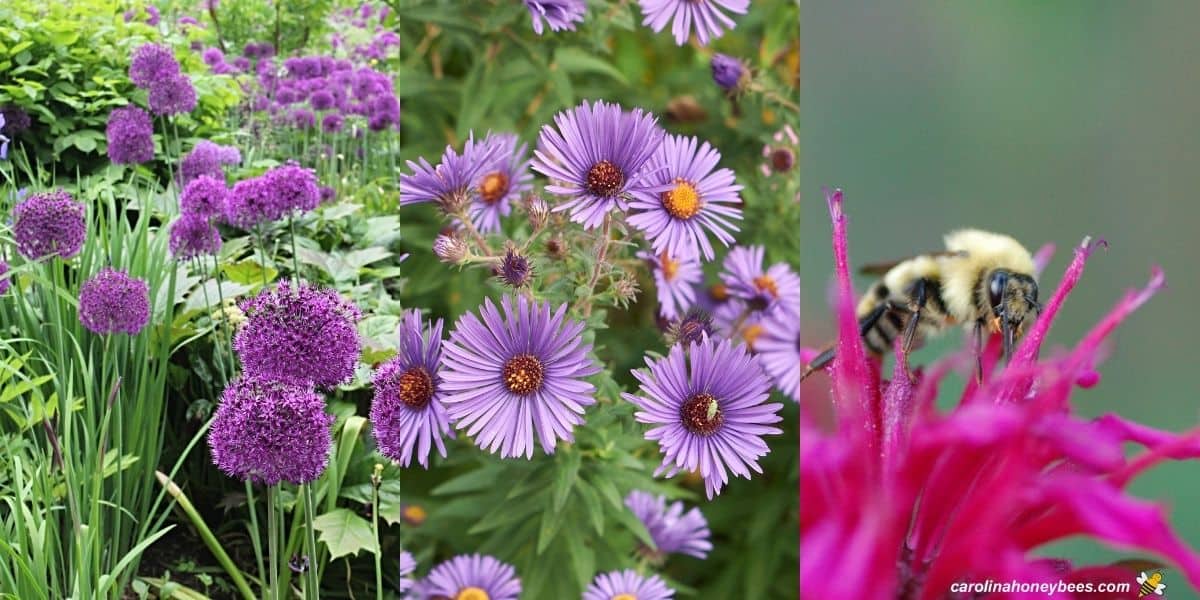
1. Allium (Ornamental Onion)
Allium is a member of the onion family. The ball shaped blooms on tall stalks make quite a statement in the garden.
It does well in dry conditions and is a favorite of bees and butterflies. This perennial is also deer resistant and not too attractive to rabbits!
2. Asters (Aster spp.)
Asters come in many different varieties and colors. Though most are small, they provide food for bees late in the season when many other plants have gone to seed.
These dependable little flowers are hardy and easy to grow. They thrive in sunny locations. You may notice many wild types growing along roadsides and in fields.
3. Bee Balm (Mondarda didyma)
Bee Balm is an interesting plant. We know it must be attractive to bees – it even has the word “bee” in its common name.
Bee Balm has unusual frilly blooms and comes in several colors. It is suitable for sunny locations to partial shade.
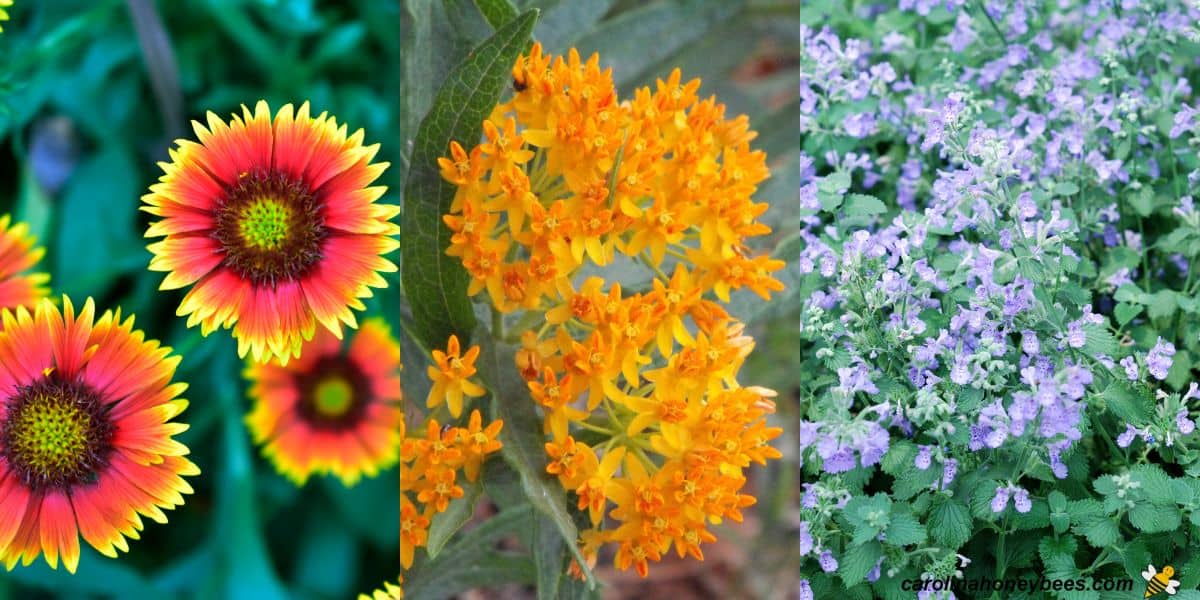
4. Blanket Flower (Gaillardia spp.)
Thriving in poor soil, blanket flower is a drought tolerant plant that bees like and is good for a ground cover. They require little care once established. They are a food source for caterpillars and many different kinds of bees.
5. Butterfly Weed (Asclepias tuberosas)
Butterfly Weed is a very drought tolerant plant. Once established it requires no maintenance from the gardener.
Happiest in a sunny spot, Butterfly Weed is also a host plant for monarch butterflies. These plants die back to the ground in Winter and grow again in the Spring.
6. Catmint (Nepeta spp.)
Catmint is a great addition to the bee garden due to its long bloom time. This mint can provide food for pollinators over several months.
It is available in several different types and a variety of sizes and spreads. Some types have an upright growth habit – others are lower growing.
Happy in full sun, this plant is a mint so give it space. Catmint is a good bee plant for containers too. And, you may have some kitty cat visitors – so keep that in mind.

6. Coneflowers (Echinacea spp.)
Coneflower is one of the most well-known bee friendly plants. Choose the common purple coneflowers (echinacea purpurea) if you are just learning about gardening. They are very hard to kill.
These dependable flowers provide food for bees early in the season. They are also a seed source for birds in late Fall and Winter.
While some birds do eat bees, in general this is not a problem and the two can co-exist in the same area.
In my region, purple coneflowers are easy to over Winter and often need thinned after several years. The more modern cultivars are also hardy but they are slower to reproduce. The oranges and yellows are beautiful but not as reliable as a nectar source.
7. Creeping Thyme (Thymus praecox)
Creeping thyme is often used as a ground cover. This low growing perennial attracts bees and butterflies when in bloom. It requires little maintenance once established. Honey bees also collect pollen from this plant.
My creeping thyme is a very interesting plant that has been slow to establish. But, I admit I have it in an area that is hard to water. Giving this plant a bit of water in the first year would be a bit help.
8. Goldenrod (Solidago spp.)
Goldenrod is a native flower that is often noticed in the wild. In Fall, the tall plants come alive with brilliant yellow blooms. Look closely and you will see bees of many kinds working the blooms.
Because it blooms at the same time as Ragweed, Goldenrod is often blamed for allergies. However, the pollen from Goldenrod is heavy and not wind borne. It does not cause your itchy eyes or stuffy nose.
Many varieties are available. This plant makes a beautiful background specimen for a backyard garden.
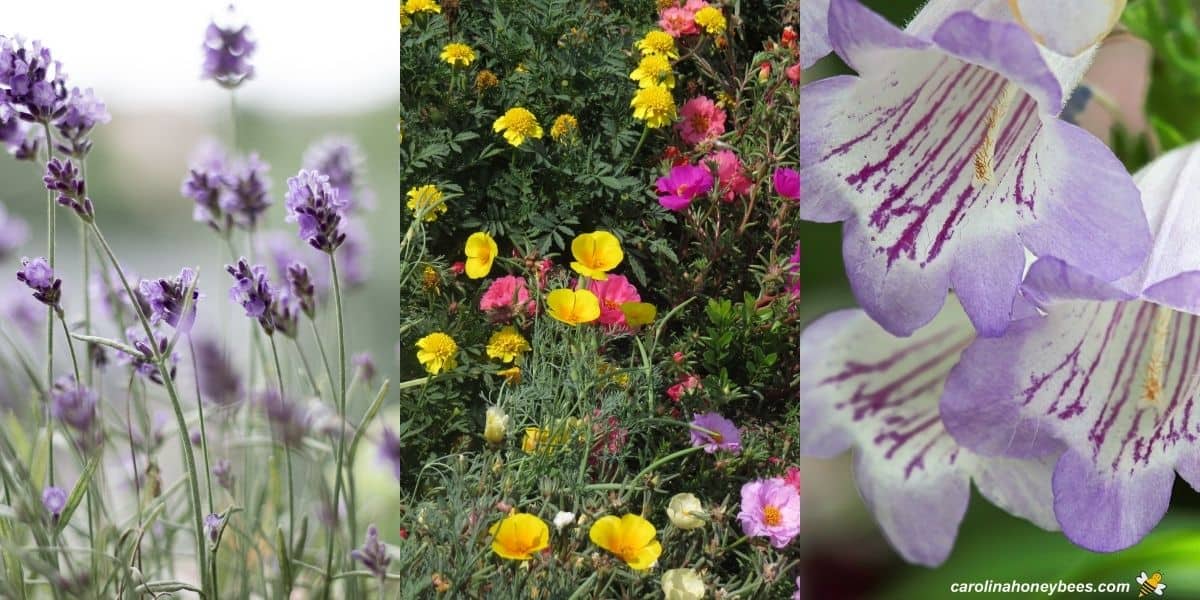
9. Lavender (Lavandula spp.)
Some species of Lavender (loved by bees) do well in dry conditions. Beautiful spikes of purple flowers appear for a long bloom period.
Some lavender plants are short but others reach several feet in height. Visited by bees, butterflies and hummingbirds – it survives well in drought once established.
10. Purslane (Portulaca)
There are many varieties of purslane – a thick leaf succulent. Some of them can be quite aggressive but overall they are good plants for natural areas in full sun.
A tough annual they brighten any area with their colorful blooms and attract bees and butterflies. Moss Rose is another name for purslane.
11. Penstemon (Beardtongue)
Beardtongue is a great plant for borders and/or cut flowers. Plant it in full sun with well drained soil. It does well as a naturalizing plant and is loved by bees – especially bumblebees.

12. Rudbeckia – Black-Eyed Susan (Rudbeckia hirta)
Rudbeckia is also known as Black-Eyed Susan. This daisy like flower is very similar in appearance to coneflowers.
Growing in clump-like fashion, the plants will quickly double in size. Providing food for many pollinators, they do best in a sunny spot. Personally, I deadhead my rudbeckia in late Fall to reduce reseeding.
13. Russian Sage (Perovskia atriplicifolia)
Russian Sage is heat tolerant but survives some cold conditions too. Perhaps one of the best plants for pollinators, blue flowers appear in mass during mid-late Summer. Providing nectar for hungry bees at a time when some sources are dry.
14. Salvia (Salvia spp.)
Salvia, also known as Sages, are available in many varieties and make an excellent addition to any pollinator garden.
This nectar rich plant is easy to grow in full sun but can take partial shade. It provides nectar over a long period to many hungry bees.
The old-world varieties are better suited for honey bees than the more modern cultivars. However, hummingbirds will enjoy all varieties.
Most Salvias need very little water but grow best in well drained soil. Some varieties will also do well in large containers.
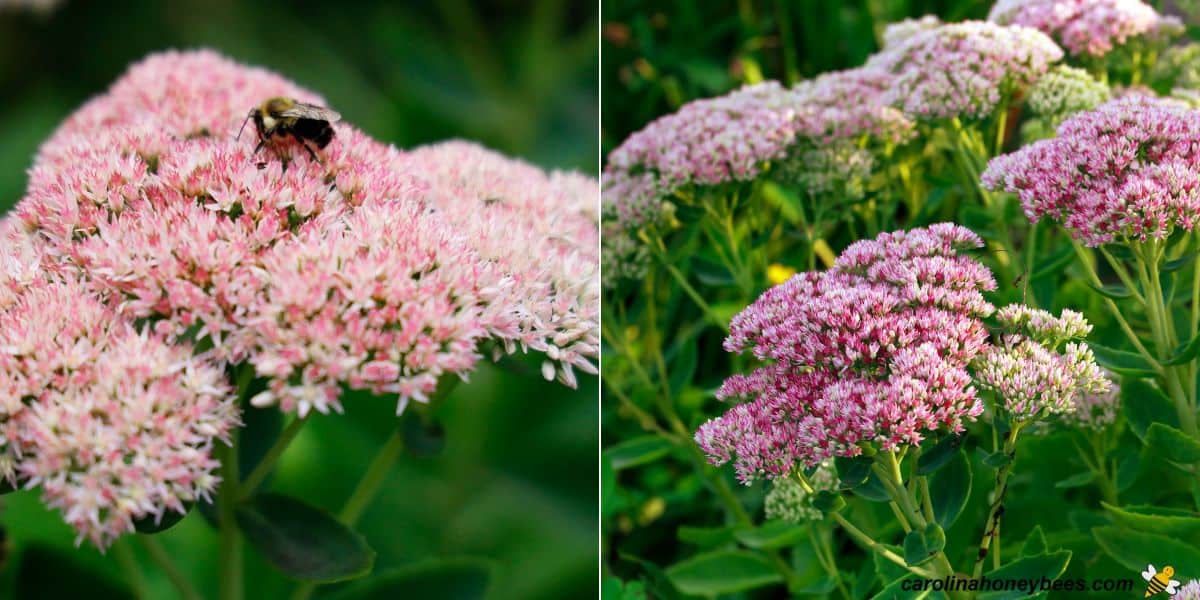
15. Sedum (Sedum spp.)
Sedum is a member of the succulent family. This is my favorite drought tolerant bee plant. It has thick fleshy leaves.
Dying back to the ground during Winter, new growth emerges in late Spring. This is a mounding plant that will fit into any location and does well in containers.
If you have a problem growing things, Sedum is the plant for you. Seeming to thrive on neglect, Sedum comes alive with late Summer blooms.
The colorful compact blooms are very attractive to bees, wasps and other pollinating insects. One of the most popular varieties is “Autumn Joy”.
However, you have several types to choose from that vary in leaf color and bloom color. Sedum is another valued plant that provides badly needed late season food.
Drought Tolerant Shrubs
There are many types of shrubs that attract bees and some of them are drought tolerant too. Shrubs are valuable as they provide many nectar rich flowers. However, they do require more space so keep that in mind.
One word of caution – some invasive plants benefit pollinators. Be sure to consult your local agricultural agency if you are in doubt.

Vitex Shrubs (Vitex agnus-castus)
Vitex is an ornamental shrub that can grow to be a small tree. It likes full sun and is very drought tolerant once established.
A deciduous shrub, vitex is covered in purple and white flowers in late Summer. This is a time in many regions when few plants are blooming making vitex very attractive to bees.
Bayberry – Wax Myrtle (Myrica penslvanica)
Bayberry, also called Wax Myrtle, is a very drought tolerant plant. Native to the Eastern sections of the US, it grows well in a variety of soil conditions including along the coast.
Do not confuse this plant with Barberry (an invasive shrub that has thorns). Bayberry is attractive to bees and produces grayish berries that can be used in crafting and feed wildlife too!
Annual or Perennials
Annual plants grow bloom and make seed in one season. They often bloom until frost. They do not return next year from the same root – though they may produce seed that return. A popular example is some of the sunflowers bees love.
Perennials are a good investment for your garden because they return year after year. Most of them are low maintenance.
But, not all of them perform well in dry weather. However, you can find some perennials that are very attractive to bees.
Expert Tips
When choosing drought tolerant plants for your bee garden keep these tips in mind:
- create groupings of similar vegetation. Instead of having 1 plant of 20 different types, create block planting. Use multiples such as having 4 plants of each type and maybe 5 different varieties in one bed
- it is also easier for the bees to find the food source when planted in blocks of similar color or type. Bees see flowers in a different way than humans and areas with multiple plants of the same kind are easier to locate
- choose plants that provide nectar used by honey bees to make honey
- include some plants that provide pollen that bees use to feed and raise baby bees
- before ordering new plants, check out the planting zones map
FAQs
Plants that are drought-tolerant often have fleshy leaves that store moisture or deep root systems that helps them survive dry conditions. If you are buying plants, read the label.
No, once established drought-tolerant plants require very little care or maintenance.
Yes, many drought-tolerant plants are well-suited for container gardening and can thrive in small spaces like balconies or patios. Choose compact varieties and ensure containers have proper drainage to prevent waterlogging.
Final Thoughts
There are thousands of flowers that bees love. Strive to have a diverse garden with many different varieties that do well in all weather conditions. If you have a lot of space, there are some bee friendly trees to consider too.


